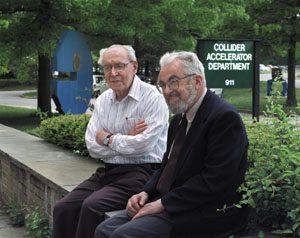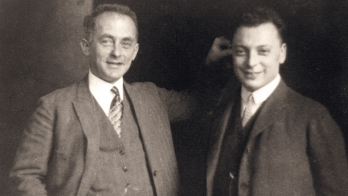Some 40 years after it was commissioned, and as well as continuing to provide particles to its own physics programme, Brookhaven’s Alternating Gradient Synchrotron has a new future as the injector for the Relativistic Heavy Ion Collider. Liz Seubert looks back at the invention of alternating gradient (strong) focusing, which made the AGS and a new generation of machines possible.

“If you can’t do two things together, you just do one after the other – that’s all there is to it!” Ernest Courant, Brookhaven distinguished scientist emeritus, was describing how he came to think of the strong-focusing principle that he, together with M Stanley Livingston and Hartland Snyder, co-discovered in 1952.
Also known as alternating gradient focusing, this principle was a breakthrough in accelerator design. At Brookhaven it resulted in the construction of the successful Alternating Gradient Synchrotron (AGS), which achieved its design energy on 29 July 1960.
In previous circular accelerators, such as Brookhaven’s Cosmotron, particles had been guided round the ring by a magnetic field made by outward-facing magnets. The magnets bent the particles’ trajectories and at the same time weakly focused them both horizontally and vertically. The particles’ energy could only be increased by enlarging the ring with wider magnets, requiring far more steel – at great cost – to make the larger number of magnets.
However, Courant and his colleagues calculated that energy could be increased dramatically with much smaller magnets if the particles were strongly focused first vertically then horizontally.
They achieved this by arranging the magnets so that their field gradients faced alternately inward and then outward around the ring. (It turned out that this idea had been proposed earlier by Nick Christofilos in Greece, but his innovation had gone unrecognized and was then forgotten. Later he was invited to Brookhaven.)
The practicality of the principle was demonstrated in 1954 by Cornell University’s 1.3 GeV electron accelerator, and in 1959, well before the AGS was finished, by CERN’s 24 GeV Proton Synchrotron.
CERN makes a scoop
On 17 May 1960 a 50 MeV beam completed one turn round the AGS ring. In July that year the 30 GeV design energy was reached and even surpassed. “But,” Courant recalled, “although we were all very excited by how quickly things were going, we were a little disappointed that we’d been scooped by CERN.”
One reason why Brookhaven had fallen behind was because it had built an electron analogue before starting construction of the AGS, Courant says. The analogue was designed to explore what is called the “transition energy” – a potentially serious problem with the synchronization behaviour. The analogue could also give information on nonlinear resonances that might affect the orbit stability of the particles as they circled the AGS ring.
“These resonances were not a big problem, but it was good to know what was happening,” said Courant . “Using the analogue, we found that the transition problem could be overcome. We also found out a lot about higher order resonances that we hadn’t expected, and we confirmed that we could go forward with the design as planned. So the delay was worth it.”
Dedicated staff
In a statement made in July 1960 as the AGS began operation, Leland Haworth, Brookhaven director at the time, congratulated Ken Green, John Blewett and the entire staff of the Accelerator Development Department for their work. He offered special congratulations to Courant, Snyder and Livingston, “whose brilliant concept of strong focusing has once more proved its great utility”.
Taking over as Brookhaven director on 1 July 1961 was Maurice Goldhaber, now distinguished scientist emeritus. From 6 to 12 September the laboratory hosted the 1961 International Conference on High Energy Accelerators. Immediately following the conference, the AGS dedication ceremony was held. Goldhaber had just returned from a celebration in Manchester for the 50th anniversary of the discovery of the nucleus by Ernest Rutherford.
On the return flight, Goldhaber wrote the talk that he was to give at the AGS dedication: “Why high-energy physics?”. Unsurprisingly, Goldhaber’s words on the science lying ahead at the AGS are relevant today in the new age of the AGS’s mighty spin-off partner, the Relativistic Heavy Ion Collider.
In his talk, Goldhaber described experimentalists, eager to work on the new machine “on the border between light and dark, where no complete set of guiding principles is as yet established. Today, the border between light and dark has moved to questions of nuclear structure, of the structure of elementary particles, and of the forces between them,” he also noted. “Research with these machines is a great adventure; it leads us nearer to the heart of the particles of which we all are built. To think of something more exciting is difficult.”
Strong-focusing accelerators
At the end of 1999, CERN celebrated the 40th anniversary of its Proton Synchrotron. This machine and the Brookhaven AGS were the world’s pioneer proton strong focusing accelerators. That both of them are also the hub of complex and ongoing beam networks testifies to the importance of the invention of the strong focusing technique. Other machines that opted for the comfort of the then conventional weak focusing are now history.
In 1952, even before CERN had formally been created, the declared goal of the proposed European laboratory was to build a scaled-up version of Brookhaven’s 3 GeV Cosmotron, then nearing completion. In 1952 a group of European pioneers visited Brookhaven to see Cosmotron preparations. The visit prompted the Brookhaven accelerator experts to organize a brainstorming session. The outcome was alternating gradient (strong) focusing. On his return, Odd Dahl boldly insisted that the new European machine should go for the untried focusing technique. CERN went for it, and the European machine was even commissioned several months before that at Brookhaven. The CERN machine’s 40th anniversary was featured in the December 1999 issue of CERN Courier.
*This article originally appeared in the 4 August issue of the Brookhaven Bulletin.








